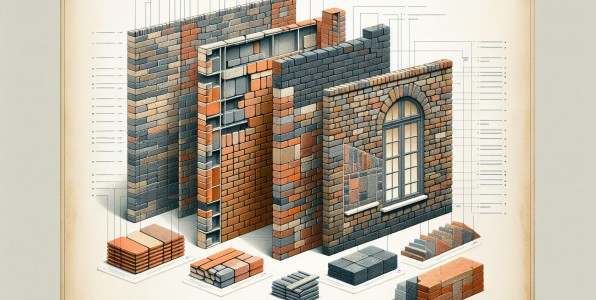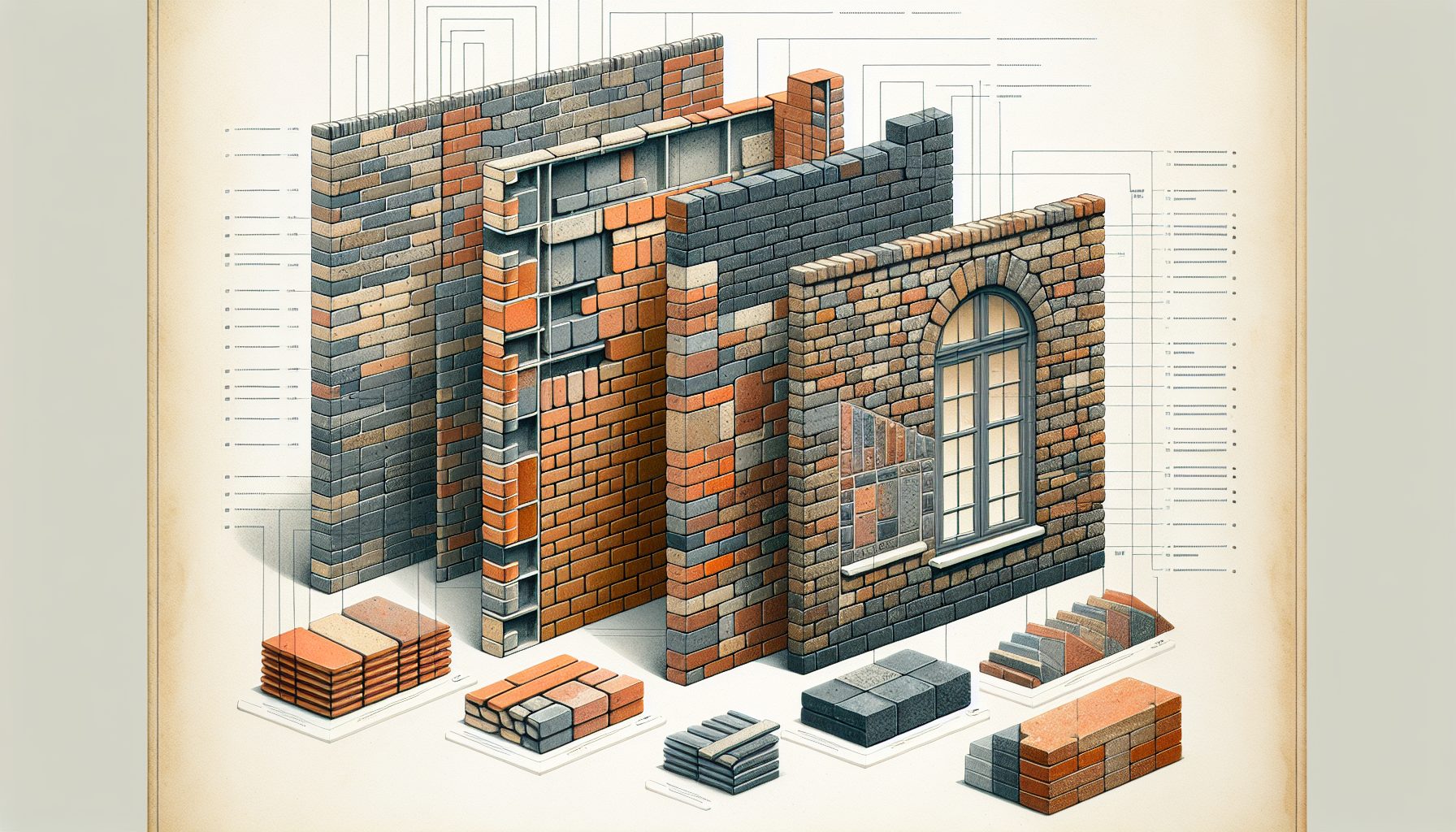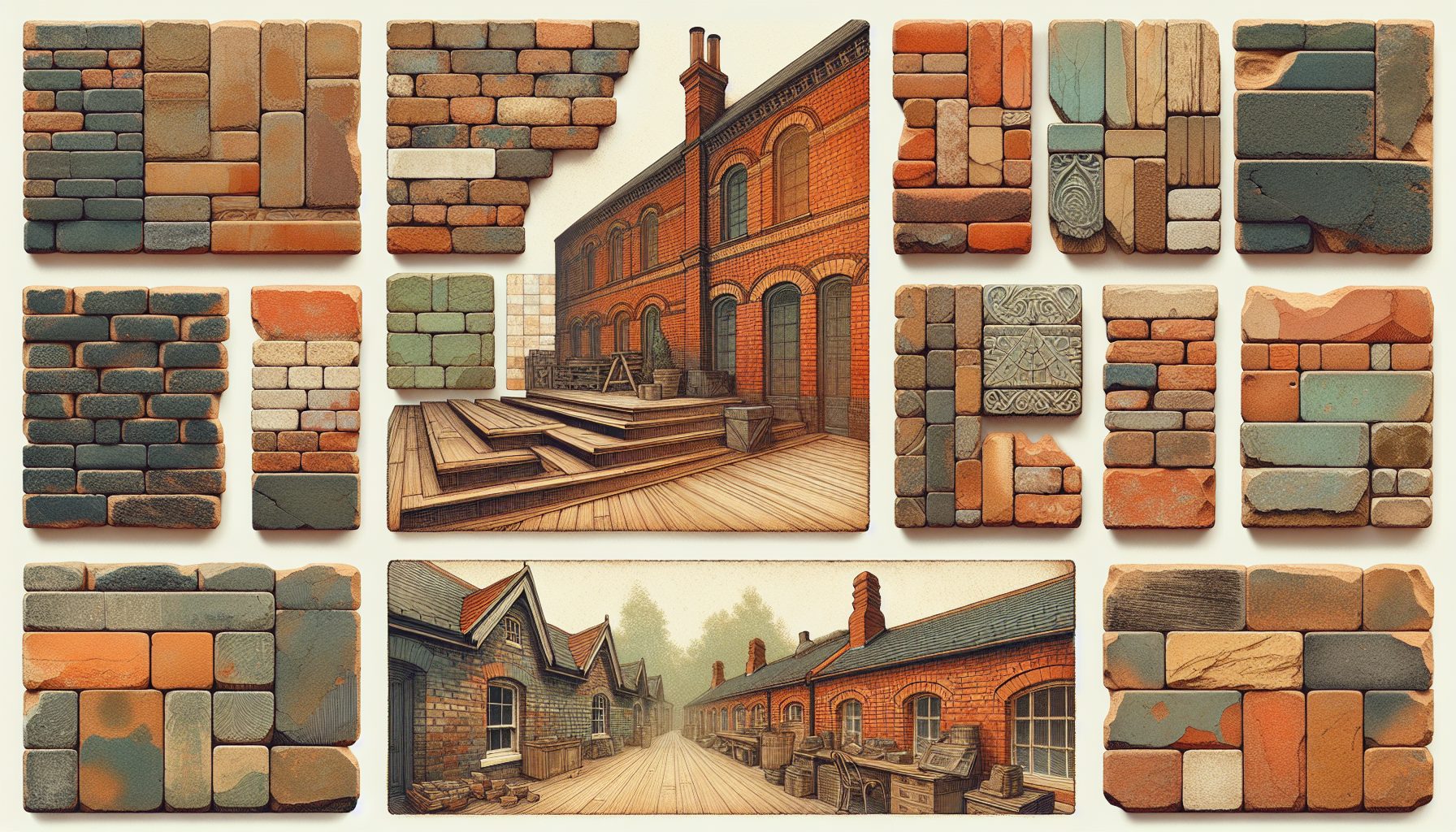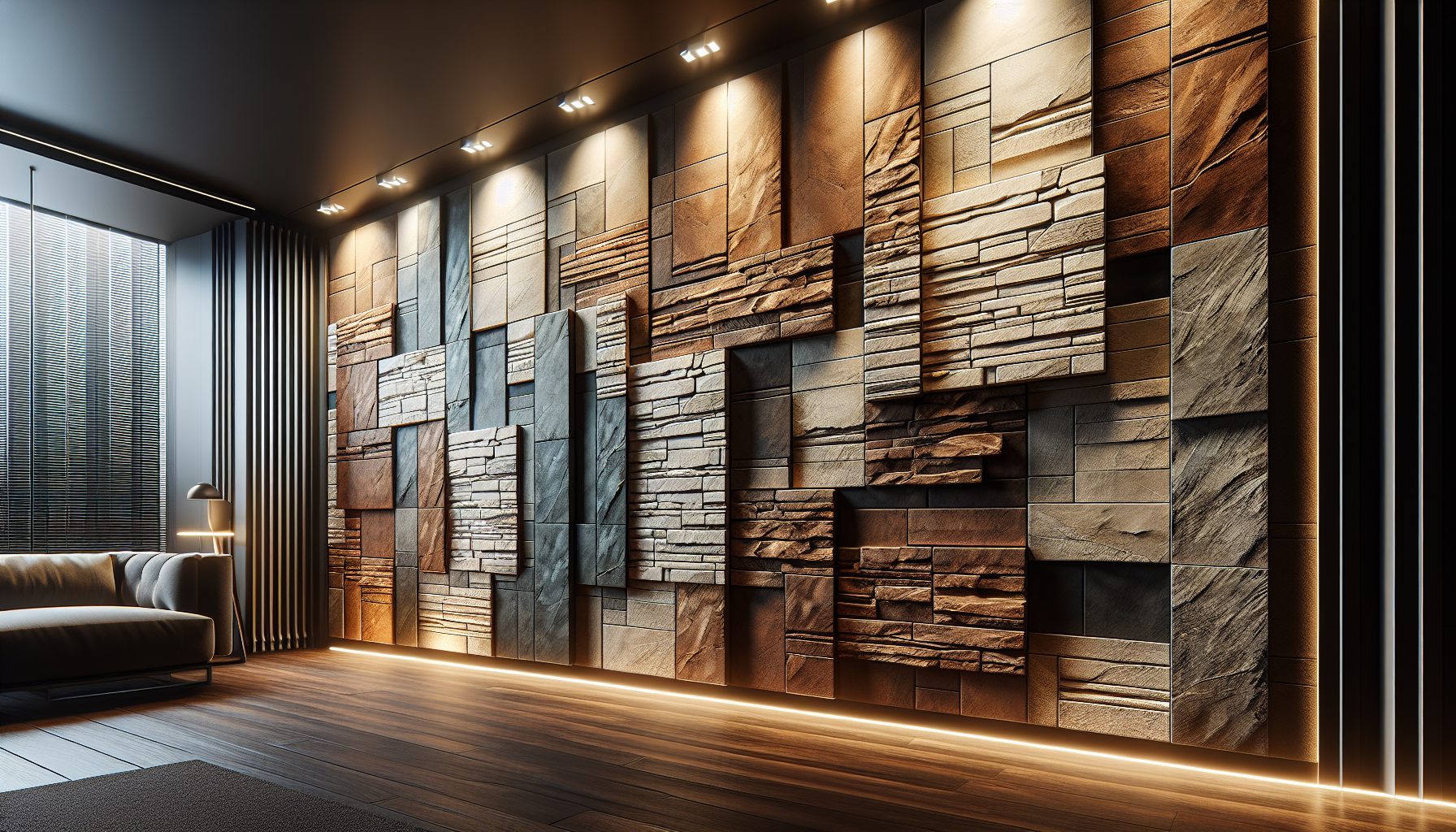Brick Cladding Options for External Walls

Brick Cladding Options for External Walls
The post Brick Cladding Options for External Walls appeared first on UK Construction Blog.
Brick cladding enhances building aesthetics and durability. This guide covers top brick cladding options, including types, benefits, and installation tips for external walls.
Key Takeaways
- Brick cladding systems provide a durable and efficient solution for enhancing building aesthetics while offering various types, including brick slips, handmade tiles, and modern brick effect panels.
- Proper installation over suitable substrates and the inclusion of movement joints are critical for the long-term performance and durability of brick cladding systems.
- Reclaimed brick slips offer an eco-friendly and cost-effective option, adding unique character and reducing environmental impact by repurposing materials.
Understanding Brick Cladding Systems

Brick cladding systems are an ingenious way to combine the timeless appeal of traditional brick with modern construction techniques. These systems offer a plethora of design possibilities and enhance the structural integrity of buildings. Some benefits of brick cladding include:
- Creating stunning facades
- Adding rustic charm to interiors
- Transforming building aesthetics
- Minimal maintenance required
- Resisting fading, weathering, and erosion
Brick cladding systems are designed to withstand the test of time, making them a durable and reliable choice for any construction project.
One of the attractions of brick cladding systems lies in their simplified installation process. Their design mitigates common installation issues, providing a smoother, more efficient construction experience, which makes them popular among builders and architects. The benefits of brick cladding systems include:
- Simplified installation process
- Mitigation of common installation issues
- Smoother, more efficient construction experience
- Versatility in patterns, textures, and colours for endless customization
These benefits make brick cladding systems a great choice for any architectural style or personal preference.
A thorough exploration of brick cladding necessitates understanding the various types available, compatible substrates for installation, and the role of movement joints in accommodating building expansion and contraction.
Types of Brick Cladding Systems
There are several types of brick cladding systems, each offering unique benefits and aesthetic appeal. Brick slips, for instance, are thin slices of real brick that are commonly used in both interior and exterior applications. These slips provide the look of traditional brickwork without the need for full-sized bricks, making them a cost-effective and versatile option.
Handmade brick tiles are another popular choice, crafted from real bricks and offering a unique, handcrafted appearance that adds character to any space.
Modern brick effect wall panels are designed to mimic the appearance of traditional brick walls without the associated costs. These panels are lightweight, easy to install, and come in a variety of styles and finishes, making them an attractive option for those looking to achieve a brick look on a budget.
Each of these types of brick cladding systems brings its own set of benefits, catering to different needs and preferences.
Suitable Substrates for Installation
Brick cladding can be installed on a variety of substrates, making it a versatile choice for different building types. Commonly suitable substrates include:
- brick
- breezeblock
- steel
- timber frame buildings
Additionally, brick cladding can be installed over existing siding, provided that the old siding is in good condition. This flexibility allows for the enhancement of various structures, from modern steel-framed buildings to traditional timber houses.
If brick cladding is installed on existing surfaces, proper substrate preparation is paramount to ensure a secure and durable attachment. Proper preparation includes cleaning the surface, repairing any damages, and applying a suitable primer if necessary. By following these steps, you can achieve a seamless and long-lasting brick cladding installation.
Movement Joints and Building Expansion
Movement joints are a critical component in any building to accommodate expansion and contraction due to temperature changes and settlement. These joints allow the building to “breathe� and adjust without causing damage to the cladding or the structure itself. Without movement joints, buildings are susceptible to cracks and other structural issues, which can compromise both the aesthetics and integrity of the brick cladding.
It is imperative for builders to strategically plan and install movement joints, ensuring the cladding system can accommodate these natural movements. By doing so, they can maintain the appearance and functionality of the brick cladding over time, ensuring that it remains a durable and attractive feature of the building.
Brick Slips for Internal and External Use

Brick slips are a fantastic option for those looking to add the charm of traditional brickwork to both internal and external spaces. Made from real clay bricks, brick slip tiles are thin layers that mimic the appearance of full-sized bricks, offering a natural tile effect without the bulk. They are versatile enough to be used over existing external brickwork and cladding insulation, making them suitable for a wide range of applications. Some benefits of using brick slips include:
- Easy installation
- Lightweight and flexible
- Durable and long-lasting
- Wide range of colours and styles available
- Can be used both indoors and outdoors
- Provides insulation and soundproofing properties
With all these advantages, it’s no wonder that brick slips are becoming a popular choice for homeowners and designers alike.
Whether you’re looking to create a feature wall, enhance a chimney breast, or add character to a garage or extension, brick slips provide a stylish and practical solution. One of the key advantages of brick slips is their availability in a wide range of colours, designs, and styles, allowing for endless customization to suit any aesthetic. From rustic reds to sleek greys, there’s a brick slip to match every design vision.
Exterior Brick Slips
Exterior brick slips are designed to withstand the harshest weather conditions, providing both durability and aesthetic appeal. Some key features of exterior brick slips include:
- Fully frost-resistant, helping prevent frost damage and maintain the wall’s integrity over time
- Weather resistance, protecting against structural damage caused by extreme weather conditions
- Excellent choice for outdoor applications
Maintaining exterior brick slips is fairly simple, typically requiring a basic wash to sustain their fresh and vibrant appearance. Additionally, buildings with brick cladding are more resistant to humidity and mould, contributing to a healthier living environment. Using copings on top of the wall can further reduce water penetration into the brickwork, enhancing the overall durability of the cladding.
Interior Brick Slips
Interior brick slips offer a cost-effective way to achieve the look of a traditional brick wall without the need for full bricks. These slips can be used to create stunning feature walls in various interior spaces, adding warmth and character to:
- living rooms
- kitchens
- bedrooms
- dining rooms
- home offices
- entryways
The versatility of interior brick slips allows for endless design possibilities, from rustic charm to modern chic.
Affordability stands as a key benefit of interior brick slips. By opting for brick slips instead of full bricks, homeowners can achieve a high-end look without breaking the bank. This makes brick slips an attractive option for budget-conscious renovations and design projects.
Reclaimed Brick Slips

Reclaimed brick slips are a sustainable and authentic option for those looking to add a touch of history and character to their projects. These slips are cut from bricks reclaimed from previous construction projects, helping to minimize waste and reduce carbon emissions. By reusing materials that would otherwise end up in landfills, reclaimed brick slips offer an eco-friendly alternative to new bricks.
In addition to their environmental benefits, reclaimed brick slips retain the characteristics and rustic charm of full-sized bricks, making them visually indistinguishable once installed. This authenticity adds a unique and timeless appeal to any space, whether used in residential, commercial, or public settings.
Benefits of Reclaimed Brick Slips
Reclaimed brick slips offer benefits that go beyond environmental impact. These slips are an excellent choice for eco-conscious builders and homeowners looking to reduce their carbon footprint. By cutting down on landfill waste and the need for new material production, reclaimed brick slips align with sustainable building practices.
Moreover, reclaimed brick slips add character and uniqueness to projects with their variety of textures and tones. Each slip tells a story, contributing to a rich and authentic aesthetic that can’t be replicated with new materials.
Applications of Reclaimed Brick Slips
Reclaimed brick slips can be used in a variety of applications, adding a rustic and authentic touch to both interior and exterior spaces. In residential settings, they are often used to create feature walls in living rooms, adding warmth and character to the space. For home renovation projects, reclaimed brick slips can be used for exterior facades, giving an aged and timeless look that complements traditional architectural styles.
In commercial settings, reclaimed brick slips are employed for various purposes, including:
- Creating a vintage ambiance in restaurant interiors that enhances the dining experience
- Designing storefronts in retail stores to provide a unique and inviting appearance that attracts customers
- Accent walls in office spaces to create a sophisticated yet historic aesthetic that impresses clients and employees.
Handmade Brick Tiles

Handmade brick tiles are crafted using traditional methods, offering unique aesthetic appeal and design flexibility. These tiles are often created by shaping clay by hand and drying it naturally, a process that dates back centuries. The result is a product with individually crafted imperfections that add character and charm to any space.
Whether used in modern or traditional settings, handmade brick tiles bring a touch of artistry and history to any project.
Craftsmanship and Quality
The quality and durability of handmade brick tiles are guaranteed by the craftsmanship involved in their creation. These tiles are typically made from natural clay, which contributes to their resistance to weather damage and wear and tear. The process of making these tiles involves shaping each piece by hand using a wooden mould dusted with sand, followed by air-drying to develop unique textures.
Once dried, the bricks are fired in a coal kiln, where variations in temperature create different colours and textures. This traditional method results in tiles that are not only durable but also rich in character and individuality. Homeowners and architects alike appreciate the authentic look and superior quality of handmade brick tiles.
Design Flexibility
Handmade brick tiles offer an extensive range of textures and colors, providing immense design flexibility for bespoke projects. These tiles can be customized to suit various design aesthetics, from rustic and traditional to sleek and modern. The unique variations in each tile make them perfect for creating personalized and distinctive spaces, whether in residential homes, bars, or commercial properties.
Furthermore, the different styles and finishes available enhance the versatility of handmade brick tiles. Architects and interior designers often choose these tiles for their ability to add a unique touch to any project, ensuring that each application stands out.
This flexibility allows for the creation of spaces that are both beautiful and functional, catering to the specific needs and tastes of clients.
Modern Brick Effect Wall Panels

Modern brick effect wall panels provide a stylish and cost-effective alternative to traditional brickwork. These panels are designed to mimic the appearance of exposed brick, offering a similar aesthetic without the associated expenses. They are lightweight and easy to install, making them an attractive option for both residential and commercial projects.
One of the main advantages of brick effect wall panels is their ability to transform spaces quickly and affordably. Whether you’re looking to create an urban chic look or add rustic charm to a room, these panels offer a versatile solution that doesn’t compromise on appearance. With a range of styles and finishes available, they can be tailored to suit different tastes and design visions.
Installation Process
With a straightforward installation process, brick effect wall panels are accessible to both DIY enthusiasts and professionals. Here’s how to install them:
- Start by preparing the wall, ensuring all surfaces are protected and plug sockets and switches are removed.
- Score and prime the wall to maximize adhesion for the tiles.
- The panels often come with a tongue-and-groove design, which simplifies the installation process.
To install brick effect wall panels, follow these steps:
- Cut the panels to size as needed.
- Adhere the panels to the walls using a suitable adhesive.
- Allow the adhesive to dry for 24 hours before applying mortar.
This easy installation process makes brick effect wall panels a convenient choice for those looking to achieve a brick look without the hassle of traditional masonry.
Design Options
Modern brick effect wall panels come in a variety of styles and finishes, allowing for extensive customization to suit different tastes and architectural styles. From industrial and urban designs to more rustic and traditional looks, these panels can be used to create various aesthetic effects. This versatility makes them suitable for a wide range of applications, including:
- Contemporary apartments
- Vintage-themed restaurants
- Industrial-style offices
- Rustic cafes
- Urban-inspired retail spaces
Additionally, digital processes allow brick cladding systems to mimic the appearance of any brick, texture, and colour. This means that you can achieve the exact look you desire, whether you’re aiming for a sleek modern finish or a classic brick façade. The wide range of design options ensures that there’s a brick effect wall panel to match every vision and project.
Stone Cladding for a Natural Look
Stone cladding offers a natural and sophisticated appearance, making it a popular choice for both interior and exterior applications. These products enhance the aesthetic appeal of new builds and renovation projects alike, providing a timeless and elegant look. Whether used to create a rustic exterior façade or a luxurious interior feature wall, stone cladding adds a touch of class to any space.
One of the main benefits of stone cladding is its versatility. It can be used to create a natural stone appearance in various settings, from traditional homes to modern commercial buildings. The wide range of materials and finishes available ensures that there’s a stone cladding option to suit every design preference and project requirement.
Types of Stone Cladding
There are several types of stone cladding materials, each offering unique textures and patterns. Common options include sandstone, limestone, granite, and slate, each providing a distinct aesthetic. Natural stone cladding panels are available in different styles, such as split face stone, coursed stone, and random stone, catering to various design preferences.
For those looking for a more cost-effective alternative, simulated stone veneers offer a lightweight and affordable option that closely mimics the appearance of real stone. Eco-friendly alternatives, such as engineered stone and recycled stone products, provide sustainable options without compromising on the natural look.
Benefits of Stone Cladding
Stone cladding offers numerous benefits, making it a desirable choice for many projects. Its durability is a key advantage, as stone cladding can withstand harsh weather conditions, heat, moisture, and impacts, making it ideal for high-traffic areas. The natural textures and patterns of stone cladding add elegance and sophistication to any space, enhancing its overall aesthetic appeal.
In addition to its visual and structural benefits, stone cladding is easy to maintain. Its non-porous surface resists stains and bacteria growth, requiring only mild soap and water for cleaning. Stone cladding also offers natural resistance to dampness and water leaks, making it a practical and long-lasting solution for both interior and exterior applications.
Fibre Cement Cladding
Fibre cement cladding is a durable and low-maintenance option for building exteriors, making it an ideal choice for modern construction projects. This material combines the benefits of cement and cellulose fibres to create a strong and resilient cladding solution. Its ability to withstand harsh weather conditions, resist rot and insects, and provide excellent fire resistance makes fibre cement cladding a reliable option for various applications.
Fibre cement cladding is also known for its aesthetic versatility. It can be manufactured to mimic the appearance of wood, stone, or other materials, providing a wide range of design options. This flexibility allows architects and builders to achieve the desired look while benefiting from the durability and low maintenance of fibre cement.
Properties of Fibre Cement
Fibre cement’s properties render it an exceedingly durable and practical option for cladding. Its resistance to rot, insects, and UV damage ensures its longevity, even in harsh environments. Fibre cement is also capable of withstanding high winds, hail, and other severe weather conditions, making it suitable for use in various climates.
In addition to its durability, fibre cement cladding offers the following benefits:
- Excellent fire resistance, often achieving fire ratings of up to one hour
- Secure option for buildings, providing an added layer of protection against fire hazards
- Lighter than brick or stone, facilitating easier installation and reducing labor costs.
Application Areas
Fibre cement cladding is suitable for both residential and commercial buildings, as well as high-rise structures. Its lightweight and high strength make it particularly suitable for tall buildings, where reducing the load on the structure is crucial. Fibre cement can be used for exterior facades, providing a durable and attractive finish that enhances the building’s curb appeal.
In addition to exterior applications, fibre cement cladding can also be used for interior wall linings, offering a practical and stylish solution for various rooms. Its versatility and durability make it a popular choice for contemporary construction projects, ensuring long-lasting performance and aesthetic appeal.
Budget-Friendly Brick Cladding Solutions
Budget-friendly options for brick cladding include:
- Brick slip cladding systems, which provide a cost-effective alternative to traditional brickwork
- These systems are designed to be thinner and lighter, reducing material costs
- Installation is quicker and easier compared to traditional brickwork
These options offer the same aesthetic appeal as brick cladding without the high costs.
Reclaimed brick slips offer several benefits:
- They are a budget-friendly option, as they eliminate the production expenses associated with new materials.
- They allow you to achieve a unique and authentic look.
- They help reduce your project’s environmental impact.
- They are cost-effective materials that make it possible to create beautiful and durable brick cladding on a budget.
Cost-Effective Materials
Both price and quality must be considered when selecting cost-effective materials for brick cladding. Brick slip cladding systems are generally more budget-friendly compared to full brick walls, as they use fewer raw materials and require less labour for installation. Reclaimed brick slips offer further savings by repurposing existing materials, reducing the need for new production.
High-quality brick slips are crucial for ensuring the long-term performance and appearance of the cladding system. Early analysis of cost efficiency is important to avoid redesigns and delays, ensuring that the project stays within budget while meeting all aesthetic and functional requirements.
Maintaining Quality
Maintaining quality in budget-friendly brick cladding solutions requires proper installation and regular maintenance. Choosing high-quality brick slips and a reliable mechanically fixed system is essential for the cladding’s durability and visual appeal. Professional installation by experienced contractors ensures that the cladding system performs well over time.
Regular maintenance, such as cleaning and inspecting for any damages, helps retain the quality and appearance of the cladding. Ensuring that the installation follows the manufacturer’s guidelines and adheres to local building codes is also crucial for long-term success. By taking these steps, you can enjoy the benefits of budget-friendly brick cladding without compromising on quality.
Choosing the Right Brick Cladding for Your Project
Choosing the appropriate brick cladding for your project requires a balance between aesthetics, durability, functionality, and budget. The wide range of options available means that there’s a cladding solution to suit every need and preference. By considering factors such as design flexibility, matching existing brickwork, and eco-friendliness, you can make an informed decision that enhances your building’s appearance and performance.
Factors to Consider
Several factors should be considered when selecting brick cladding. Here are some key points to keep in mind:
- Stone cladding adds significant value to properties due to its aesthetic appeal and desirability among homebuyers.
- The versatility of brick cladding allows for various textures and finishes, making it possible to match or contrast existing brickwork as needed.
- Considering the environmental impact of your choice, such as opting for reclaimed brick slips, can also contribute to a more sustainable project.
Expert Recommendations
Experts suggest the following steps for a successful brick cladding installation:
- Conduct a thorough budget assessment to identify cost-effective options without sacrificing quality.
- Properly prepare the substrate before installing the cladding.
- Use appropriate adhesives and follow the manufacturer’s guidelines for installation.
- Ensure compliance with local building codes to ensure structural integrity and weather resistance.
By following these steps, you can ensure the longevity and durability of your brick cladding system.
For those seeking an eco-friendly option, reclaimed brick slips are highly recommended. They offer a sustainable choice with a unique visual appeal, contributing to both the aesthetic and environmental goals of the project.
Summary
In summary, brick cladding systems offer a versatile and durable solution for enhancing the aesthetic and structural integrity of buildings. From traditional brick slips and handmade brick tiles to modern brick effect wall panels and stone cladding, there are numerous options to suit various design preferences and budgets. Each type of cladding brings its own set of benefits, making it possible to achieve the desired look and functionality for any project.
By carefully considering factors such as aesthetics, durability, functionality, and budget, you can choose the right brick cladding for your needs. Whether you’re aiming for a rustic, traditional, or contemporary look, there is a cladding solution that will help you create a beautiful and lasting impression. Make an informed decision and transform your building with the perfect brick cladding option.
Frequently Asked Questions
What are brick slips?
Brick slips are thin layers of traditional facing brick made from real clay bricks, suitable for both internal and external applications, offering the look of full-sized bricks without the bulk. They are a versatile and convenient way to achieve a brick finish.
How do I choose the right brick cladding for my project?
When choosing brick cladding, consider aesthetics, durability, functionality, budget, design flexibility, and eco-friendliness. It’s important to follow expert recommendations for substrate preparation and adhere to manufacturer guidelines.
What are the benefits of reclaimed brick slips?
Reclaimed brick slips offer environmental benefits by reducing landfill waste and adding unique character to projects with their rustic charm.
Can brick cladding be installed over existing siding?
Yes, brick cladding can be installed over existing siding as long as the old siding is in good condition and the substrate is properly prepared.
What are the maintenance requirements for stone cladding?
Stone cladding requires minimal maintenance because of its non-porous surface, which resists stains and bacteria growth. Regular cleaning with mild soap and water is usually sufficient.
Comments are closed